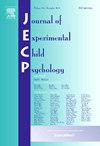The effects of phonological and semantic similarity on early referent identification
IF 1.8
2区 心理学
Q3 PSYCHOLOGY, DEVELOPMENTAL
引用次数: 0
Abstract
Language processing encompasses a sophisticated interplay of phonological (sound-based) and semantic (meaning-based) processes. This intricate interaction develops progressively during early language acquisition. It involves not only the addition of new words to the child’s vocabulary but also the evolving organization of lexico-semantic networks. The aim of the current research was to investigate how young children navigate the complexities of word relationships, with a focus on the interplay between phonological similarity and semantic relatedness. A preferential looking experiment was conducted involving 73 participants divided into two age groups, with 39 aged 18 months and 34 aged 24 months. The experimental design involved auditory presentation of target words together with pairs of target and distractor images that systematically varied the phonological and semantic similarity between the pairs. The results showed a significant developmental progression in young children’s phonological and semantic processing abilities. At 18 months, children predominantly responded to phonological cues, displaying challenges in distinguishing between phonologically similar words regardless of semantic context. By 24 months, there was an evident sensitivity to both phonological and semantic cues. This age group especially showed processing difficulties with words that were both phonologically similar and semantically related, suggesting a more complex integration of lexico-semantic networks. These findings underscore the pivotal role of phonological processing in early language acquisition and point to the gradual integration of semantic relationships into children’s lexicons.
语音和语义相似性对早期指代识别的影响
语言处理包括语音(基于声音)和语义(基于意义)过程的复杂互动。这种复杂的相互作用在早期语言习得过程中逐步发展。它不仅涉及在儿童词汇中添加新词,还涉及词汇-语义网络的不断发展。当前研究的目的是调查幼儿如何驾驭复杂的词汇关系,重点是语音相似性和语义相关性之间的相互作用。研究人员将 73 名参与者分成两个年龄组,其中 39 名 18 个月大,34 名 24 个月大。实验设计包括在听觉上呈现目标单词以及目标和分心图片对,系统地改变图片对之间的语音和语义相似性。结果表明,幼儿的语音和语义处理能力有明显的发展变化。18 个月大时,幼儿主要对语音线索做出反应,在区分语音相似的单词方面表现出挑战性,而与语义背景无关。到 24 个月时,幼儿对语音和语义线索都明显敏感。这个年龄组的儿童在处理语音上相似、语义上相关的单词时尤其表现出困难,这表明词汇-语义网络的整合更为复杂。这些发现强调了语音处理在早期语言习得中的关键作用,并指出语义关系会逐渐融入儿童的词典中。
本文章由计算机程序翻译,如有差异,请以英文原文为准。
求助全文
约1分钟内获得全文
求助全文
来源期刊

Journal of Experimental Child Psychology
Multiple-
CiteScore
4.50
自引率
7.70%
发文量
190
期刊介绍:
The Journal of Experimental Child Psychology is an excellent source of information concerning all aspects of the development of children. It includes empirical psychological research on cognitive, social/emotional, and physical development. In addition, the journal periodically publishes Special Topic issues.
 求助内容:
求助内容: 应助结果提醒方式:
应助结果提醒方式:


